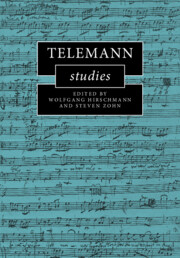Book contents
- Telemann Studies
- Cambridge Composer Studies
- Telemann Studies
- Copyright page
- Contents
- Figures
- Music Examples
- Tables
- Appendices
- Contributors
- Preface
- Abbreviations
- Part I Enlightenment Perspectives
- Part II Urban and Courtly Contexts
- Part III Nature (and) Theology in the Late Vocal Works
- Part IV Bach Family Connections
- 10 Telemann as “General Kapellmeister” to the Bach Family
- 11 Style as Substance
- 12 Sacred Pastiches
- Part V Cantata Cycles in Frankfurt, Hamburg, and Beyond
- Index of Telemann’s Works
- General Index
12 - Sacred Pastiches
Telemann Chorales in C. P. E. Bach’s Hamburg Church Music
from Part IV - Bach Family Connections
Published online by Cambridge University Press: 14 July 2022
- Telemann Studies
- Cambridge Composer Studies
- Telemann Studies
- Copyright page
- Contents
- Figures
- Music Examples
- Tables
- Appendices
- Contributors
- Preface
- Abbreviations
- Part I Enlightenment Perspectives
- Part II Urban and Courtly Contexts
- Part III Nature (and) Theology in the Late Vocal Works
- Part IV Bach Family Connections
- 10 Telemann as “General Kapellmeister” to the Bach Family
- 11 Style as Substance
- 12 Sacred Pastiches
- Part V Cantata Cycles in Frankfurt, Hamburg, and Beyond
- Index of Telemann’s Works
- General Index
Summary
In his Hamburg passions and cantatas, Carl Philipp Emanuel Bach borrowed music by a variety of contemporary composers, including Telemann, his godfather and immediate predecessor as music director in Hamburg. Most of these borrowings have been identified, but the chorales represent a special case, for even those of known origin may pose questions about how Bach adapted and performed them. This chapter focuses on Bach’s chorales with connections to Telemann, showing that some previously considered to be adaptations from the latter’s Fast allgemeines Musicalisches Lieder-Buch (1730) may in fact have different models. Other chorales, drawn from Telemann’s published cantata cycle Musicalisches Lob Gottes (1744), necessitated the adaptation of the original three-voice settings for four voices. Surviving sources indicate that Bach either composed a new voice or added a tenor line that doubles the soprano line an octave lower. In cases where Bach’s scores call for the insertion of a Telemann chorale but no performance parts survive to reveal the adaptation process, I turn to the models of Bach himself and of Telemann’s grandson, Georg Michael, whose own adaptations of chorales suggest possible solutions.
Keywords
- Type
- Chapter
- Information
- Telemann Studies , pp. 250 - 270Publisher: Cambridge University PressPrint publication year: 2022

